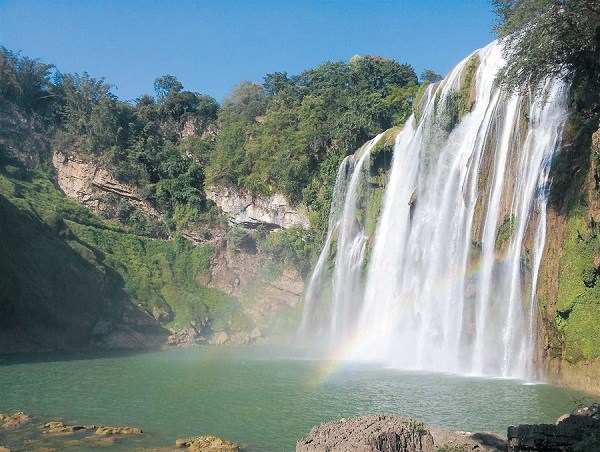Guizhou get-away offers for Zhejiang travelers
 0 Comment(s)
0 Comment(s) Print
Print E-mail Shanghai Daily, August 10, 2016
E-mail Shanghai Daily, August 10, 2016
|
|
|
Huangguoshu Waterfall |
Guizhou Province is off the radar of most Chinese travelers living along the country's east coast. Many know it simply as a faraway place where minority groups practice their traditional cultures in seclusion from modern society.
Nevertheless, there is a bond linking Guizhou and Zhejiang Province, with the latter providing poverty-relief assistance to the former in fields like medical care, education and agriculture.
Though Guizhou is considered one of the least-developed provinces in China, its enchanting scenery has attracted many from Zhejiang. During the first half of this year, more than 13.7 million Zhejiang tourists traveled to Guizhou. More are expected to arrive when the Shanghai-Kunming bullet train opens in late August.
In appreciation for everything the province and its people have done, the Guizhou government is offering a special gift coinciding with the G20 Summit. From September 1-7, anyone with a Zhejiang identity card or residence permit can visit any Guizhou scenic attraction for free.
"This preferential tourism policy and discount will really promote exchange between the two places and help open the tourism market," says Hangzhou Vice Mayor Xie Shuangcheng. "For Hangzhou, it is an award; while for Guizhou, it is a opportunity."
Other tourists and foreigners can enjoy the discount as long as they travel from Zhejiang and show a related flight or train ticket.
During the upcoming summit, Hangzhou will hold a seven-day holiday to relieve traffic congestion and yield roads to motorcades of foreign leaders and journalists.
However, the end of the summit doesn't mean the end of the discount. From September 8 to October 7, all scenic spots will continue offering 50 percent discounted tickets to travelers from Zhejiang.
In September and October, airlines will also discount some tickets to Guizhou.
Guizhou authorities are encouraging travel agencies to organize large-scale travel groups, with incentives of up to 50,000 yuan ($7,500) offered to large charter groups.
In addition to preferential policies, the Guizhou government has also signed a contract with Zhejiang on tourism industry development, market promotion and talent education.
To lure more Zhejiang travelers, Guizhou tourism departments have designed 10 "classic" traveling routes, which combine picturesque Guizhou scenery and local culture.
One of these routes takes visitors to Zhenyuan Town and Xijiang Village. Just across the river from Zhenyuan's old town, an epic vertical warren of temples, grottoes and corridors rises out of the Zhonghe Mountain in the Qinglong Cave area. This complex dates to the Ming Dynasty (1368-1644) and is integrated with Taoism, Buddhism and Confucianism.
Xijiang is known for its large population of Miao minority people, who are noted for their skills at creating silver ornaments and embroidery. The village is a living museum to the culture of the Miao. Although the group's population today numbers only about 9.4 million, their skills as craftsmen have caught the world's attention.
Another popular attraction is the Huangguoshu Waterfall. The 77.8-meter-tall, 81-meter-wide waterfall is actually part of a huge cave. The main waterfall area is recommended for adventurous explorers. Tourists are advised to take a raincoat when visiting the cascades though.
Fanjing Mountain is a national nature reserve and world biosphere reserve. It has an average temperature below 25 degrees Celsius in summer due to its geography and forest cover. As temperatures soar in July and August, the cooler heights are sure to please visitors from Zhejiang and other hot areas.
The mountain is home to an array of wildlife. Currently, 31 endangered plants and 19 threatened animals live in this protected area, including the golden monkey.
Oddly shaped rock structures reward climbers and those who brave the cable car. Check the weather before you go up though, as the best views are often obscured by clouds. Those who make the journey up on clear days will be rewarded with some spectacular views.




 Add your comments...
Add your comments...

